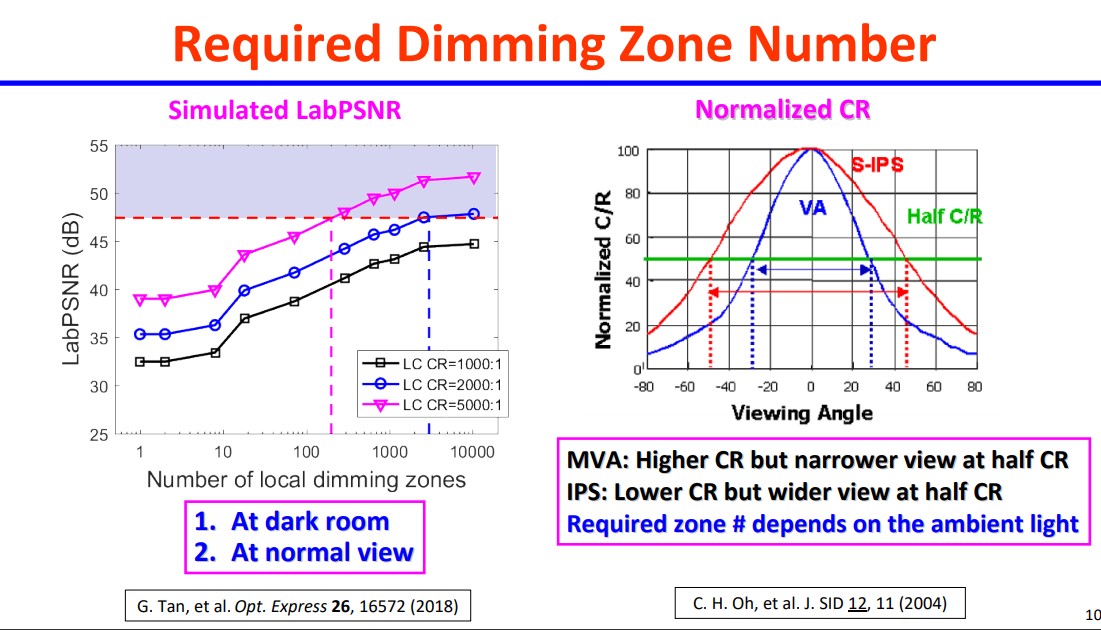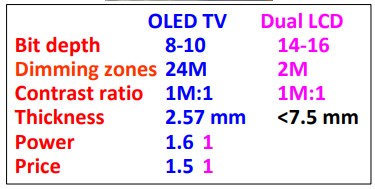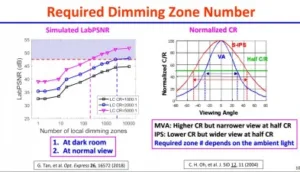As a part of SID’s Display Week 2020 Shin-Tson Wu (Pegasus Professor at the College of Optics and Photonics, University of Central Florida) gave an invited paper entitled “High-Dynamic-Range MiniLED and Dual-Cell LCDs.” Let’s summarize this valuable tutorial and analysis of the state of these impressive technologies.

The two technologies take very different routes to providing backlights with a very large number of dimming zones. One of the advantages OLED has had over the current generation of local-dimming LCDs has been what LG Display calls “pixel-level dimming.” Since each sub-pixel is its own light source, OLEDs don’t exhibit the LCD artifacts caused by the dimming zones being very much larger than the individual pixels. Both MiniLED backlights and dual cell bring the size of the dimming zones closer to pixel dimensions, thus rivaling OLED for black state and resistance to halo effect, while offering much greater peak luminance.
Wu leads off by observing that both technologies “are emerging high-dynamic-range displays because of their high luminance, high contrast ratio, greater than 12-bit depths, and long lifetime.” Both technologies have performance challlenges at oblique angles, Wu says. More to come on that.
In miniLED LCDs, the visible difference between pixel dimming and local dimming depends on both the number of local zones and the panel’s inherent contrast ratio. If the LCD’s inherent contrast ratio (CR) is 5000:1, we need only 200 zones. For a CR of 2000:1, we need 3000 zones. For a CR of 1000:1, no number of zones will remove the visual difference! (Fig. 1.) In addition, the required number of zone depends on the ambient light level.
 1. The required number of dimming zones depends upon on the native resolution of the display and the level of ambient light. (Graphics: S-T Wu)
1. The required number of dimming zones depends upon on the native resolution of the display and the level of ambient light. (Graphics: S-T Wu)
Dual-cell LCDs use a simple, unzoned backlight, with the zones provided by a monochrome LCD that sits behind the color LCD the viewer sees. For a color LCD with CR of 2000:1 and a twisted nematic monochrome LCD with CR of 1000:1, the measured CR of the system is greater than one million to one; the system delivers a 16-bit color depth with a 5-volt swing. Combining data from papers delivered at DW 2020, Wu compares some key characteristics of OLED-TV and dual-cell TV. Notably, dual cell has much greater bit depth and equivalent CR. (Fig. 2)
 2. Comparison of selected characteristics of OLED and dual-cell LCD. (Table: S-T Wu)
2. Comparison of selected characteristics of OLED and dual-cell LCD. (Table: S-T Wu)
But all technologies have their challenges. In dual cell’s case, the patterns of the two LCDs produce moiré interference when the panel is viewed at an angle, and parallax error off angle reduces brightness. In addition weight and panel thickness must be reduced.
Although miniLEDs number their dimming zones in the thousands rather than millions, that’s adequate, Wu said. Wu concluded with this:
“Both technologies offer excellent HDR and bit depths to compete with OLEDs and µLEDs.”
(KW)
Ken Werner is Principal of Nutmeg Consultants, specializing in the display industry, manufacturing, technology, and applications, including mobile devices, automotive, and television. He consults for attorneys, investment analysts, and companies re-positioning themselves within the display industry or using displays in their products. He is the 2017 recipient of the Society for Information Display’s Lewis and Beatrice Winner Award. You can reach him at [email protected] or www.nutmegconsultants.com.

